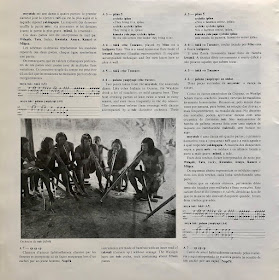Wayapi Guyane – SELAF-ORSTOM CETO 792, recorded by Jean-Michel Beaudet, 1977-1979 (LP)
This music, recorded
by French musicologist Jean-Michel Beaudet in Wayãpi, or Wayampi, villages of
Southeastern Guiana between 1977 and 1979, documents the Wayampi's traditional
way of life, fishing and hunting and subsisting off the resources of the equatorial
Amazonian forest complemented by the cultivation of a few crops like yam and
cassava. According to Beaudet, "The material civilization and social life
have changed little as a result of contacts with the Creoles and Europeans
living in Guiana."
"There are
several musical genres: various types of solo flutes played mostly for
recreation and relaxation; singing–including love songs, lullabies, and shaman
songs accompanied by malaka rattles–clarinet and pan-flute ensembles which are
now predominantly a form of collective leisure; war songs expressing nostalgia
for a Golden Age which is still seen as an ideal; and sung cycles which celebrate
the union and intimacy with their surrounding world."
The intimate, soft
and reflective music includes a tule
clarinet ensemble (A5-A6), a song for the ancestors announcing a great dance
for the next day (A2-A3), a pan flute and scraped tortoise shell (A1), a nasal
bamboo flute (A4), a bamboo flute (B1), a three-hole bone flute (B5), a
five-hole block flute (B12), various songs (A7 and B2-B4), animal calls
(B6-B10), and whistled language (B11).
Cette musique, enregistrée par le musicologue Jean-Michel
Beaudet dans des villages Wayãpi (ou Wayampi) au sud-est de la Guyane entre
1977 et 1979, documente le mode de vie traditionnel des Wayampi vivant de la
pêche, de la chasse, et de la cueillette dans la forêt équatoriale
amazonienne, plus quelques cultures de subsistance comme l’igname et le manioc.
Selon l'ethnomusicologue Jean-Michel Beaudet " La civilization matérielle
et la vie sociale des Wayapi ont été peu modifiées par les contacts avec les
populations créoles et européennes présentes en Guyane. "
" Les différents genres musicaux sont: les solos de
flûtes caractérisés par une grande variété instrumentale et qui soulignent
surtout le délassement, la tranquillité; les chants d'amour, les berceuses, les
chants des shamans accompagnés de hochets malaka;
les ensembles de clarinettes et les ensembles de flûtes de Pan dont prédomine
aujourd'hui l'aspect de divertissement collectif; les chants de guerre qui
expriment la nostalgie d'une époque magnifiée dont le modèle est toujours
vivant; enfin, les grands cycles chantés qui célèbrent plus précisément l'union
et l'intimité avec l'univers qui les entourent. "
Ces musiques Wayampi intimes, douces et contemplatives présentent
un orchestre de clarinettes tule
(A5-A6), une chanson à l'attention des ancêtres annonçant une grande danse pour
le lendemain (A2-A3), une flûte de pan et une carapace de tortue frottée (A1),
une flûte traversière nasale en bambou (A4), une flûte en bambou (B1), une
flûte en os à trois trous (B5), une flûte à bloc à cinq trous (B12), diverses chansons (A7 et B2-B4), des
appeaux (B6-B10) et du langage sifflé (B11).
Download
Our other post of Amazon Indians:
Brazil/Paraguay Indiens et Animaux Sauvages d'Amérique du Sud - UNIDISC UD 30 1293 here
Ethnomusicologist
Jean-Michel Beaudet (b. 1953) specialises in the music of the indigenous
peoples of South America's lowlands, including the Wayampi, Kali'na, and
Parikwene (French Guiana), and the Takana, Chacobo and Weenhayek (Bolivia), as
well as Kanak music and dance (New Caledonia in the Pacific Ocean).
Thank you (again) Nuno for your precious help with the visuals.
Photographs below are from Indiens de Guyane - Wayana et Wayampi de la Forêt by Jean-Marcel Hurault, Francoise and Pierre Grenand, Autrement, 1998:






















Felicitaciones por todo este increíble trabajo. Estos días bajé unos cuántos discos y en las próximas semanas los estaré escuchando.
ReplyDeleteEl placer es mio Gabriel.
Deleteanother amazing piece of music... as usual.
ReplyDeletekeep em coming my friend.
from a soulseeker :)
Thank you. You can be sure I'll keep 'em coming. Have a great summer.
DeleteSo happy to come back home after my travels and be able to start traveling again, through the brilliant music you post!
ReplyDeleteGrand merci !
Welcome back and thanks for your appreciation. I believe traveling is a state of mind, living from moment to moment, doing what's right under your nose to do, like Henry Miller talks about here using the metaphor of music:
Deletehttps://www.youtube.com/watch?v=PYL3mB3rAfU
The modern mind is rarely ever in the here and now.
I have this piece on vinyl... It is AMAZING!🙌
ReplyDeleteThank you so much for this!
ReplyDelete